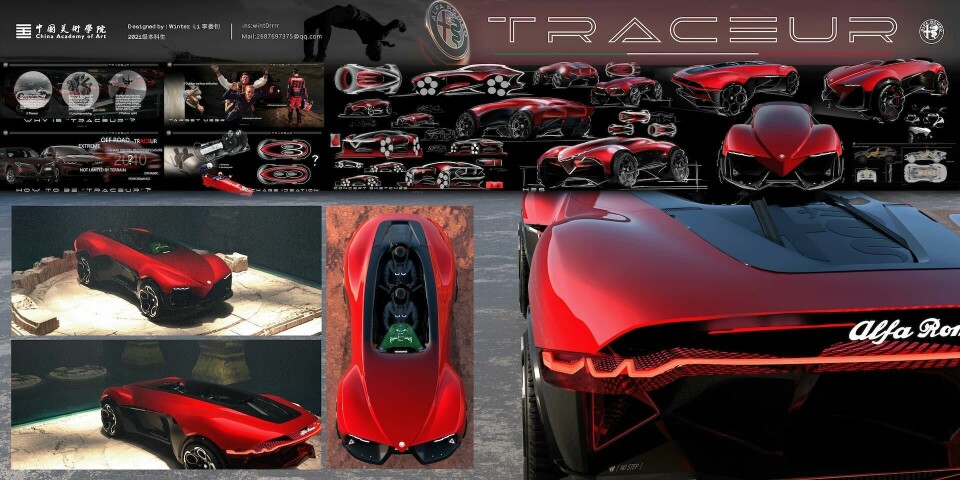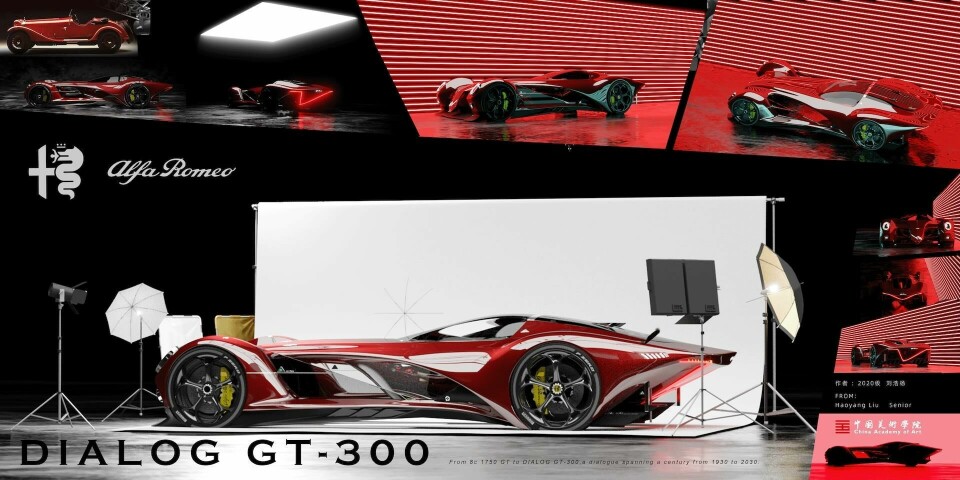
Alfa Romeo collaborates with Chinese art school
Students at the China Academy of Art have had the opportunity to work with Alfa Romeo as part of their transportation design course. CDN learns more.
In something of an unlikely collaboration, the China Academy of Art (CAA) has teamed up with Alfa Romeo to give students the chance to reimagine models for the Italian brand.
The project began by leveraging connections with Stellantis China, along with old friends and colleagues in the design community. According to course leader James Hope, it has been a win-win for all involved. The criteria, he tells Car Design News, was to view Alfa through the eyes of a young Chinese design student, “understanding the emotional feeling of the brand […] without relying on the badge or the iconic grill. To capture the soul of Alfa, if you will.”
There was a close collaboration between CAA, Stellantis China and Alfa Romeo, with the latter supporting reviews and offering design feedback during the course. “During the design brief kick-off we had the design and branding teams come to visit our campus,” explains Hope, “and they brought a new Alfa Tonale and later a Giulia for the students to experience the physical vehicles.”
In particular, Hope gives kudos to time Daniel Tang, head of design for Stellantis China and Niccolò Zamboni from Alfa Romeo’s marketing team for their hands-on involvement, ensuring students understood what Alfa Romeo is all about. For Hope, this was a chance for his students to engage with a brand they might not have expected to work with, and to consider the role of heritage in design compared to start-ups that do not have such a history behind them.
“We all agreed this would be a win-win to have Alfa interpreted by young Chinese designers,” says Hope, “who will each have their own unique approach.”
Below are examples of some of the concepts put forward, and where possible, full presentations are available to download at the end of the page.
Balance the Driving Experience by Bangmiao (Zoe) Xu
This interior and CMF-focussed concept is based on the vision of an electric sport coupe in the year 2040, channelling “performance and personality.”
It is a fitting title for the project, as the driving experience balances different driving modes including sport, normal and automatic. The latter has a focus on soft textiles, relaxing colours and an intuitive, simplified HMI built around a prominent centre console. Racing mode uses dark, contrasting colours that “submerge the user in a space of pulsating energy.”
In a nod to the iconic Alfa Romeo logo, the triangular texture of the seat covers is inspired by the scales of a snake.
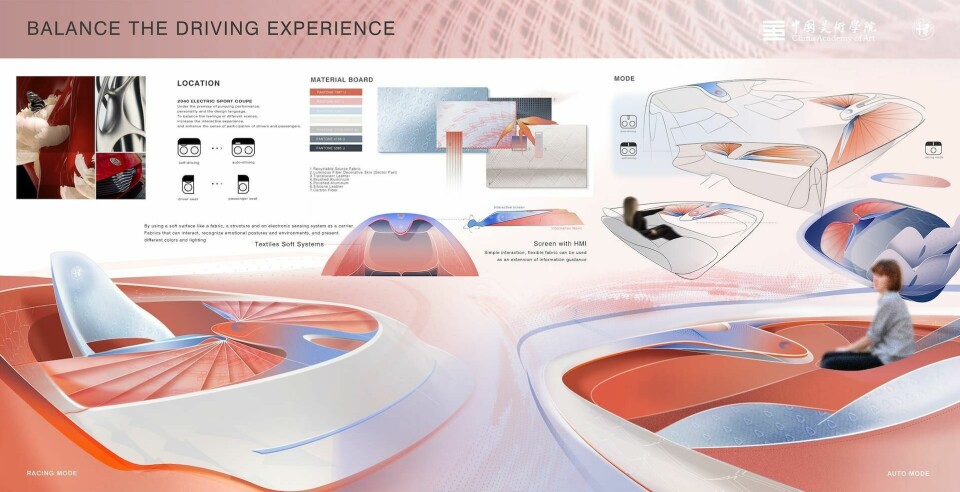
Lava concept by Blake
The year is 2033, and Alfa Romeo has released a new, racing-inspired coupe. It is partly a combination of the Tonale urban SUV and the 1970s single-seat racer, the Tipo 33/3. The result feels somewhat close to a reimagined Ferrari Purosangue, perhaps unavoidable given the mix of segments at play.
Blake takes things further by exaggerating certain proportions, such as the raised front arches that create the appearance of a viper’s face, the oversized wheels and heavily inset door panels.
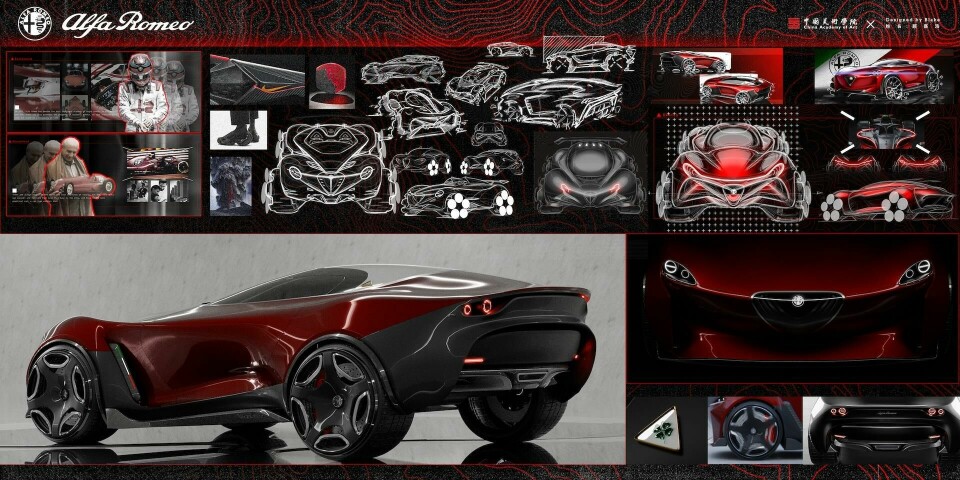
Cometa V by Brycen Liu
This concept envisions a four-seater electric supercar, inspired partly by the Lamborghini Lanzador and Koenigsegg Gemera. The Cometa V would provide high performance and a comfortable, spacious interior, while the exterior design language follows the cues of ’pure’, ‘flow’ and ’clean.’
Liu explored the iconic Alfa Romeo inverted triangle, “warping and cutting” the exterior to achieve the desired proportions. An interesting feature can be seen with the V-shaped headlamps, which flow from the front mask through the bonnet and out into the front arches, passing through a gap that presumably serves aerodynamic purpose. Shades of the 33 Stradale revealed last year can be seen at the rear, but elevated in a new way to suit the overall design.
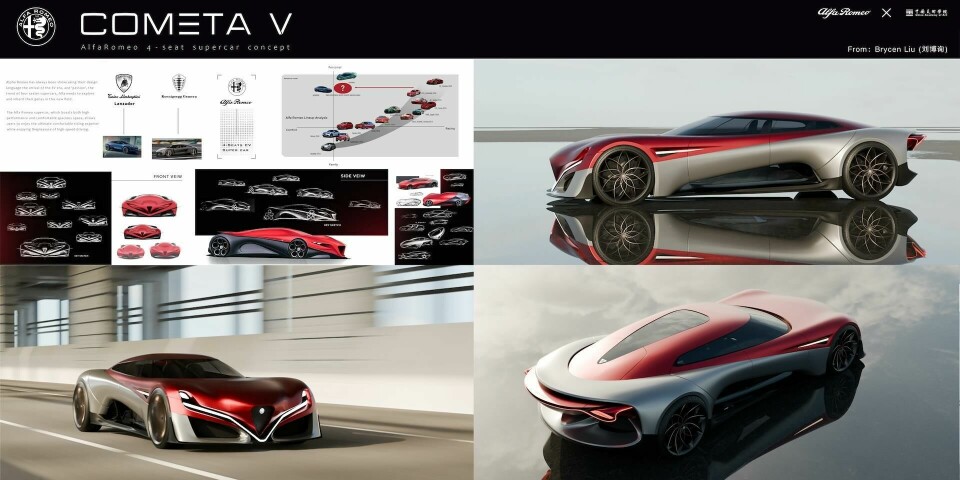
Ouroboros by Crystal Zhao
This concept is inspired by Alfa Romeo’s history of elegance and even included a look back into how Italian culture was shaped during the Roman era. The front end evokes the stance of a coiled king cobra, giving connotations of strength, status and speed.
The Ouroboros would be directed toward modern drivers looking to take scenic roadtrips, perhaps touring idyllic coastal routes. This feels fitting for a vehicle that has a wraparound shoulderline, evocative of a luxury yacht. Great care appears to have gone toward visualising the wheel design, with close-up renders of the five-spoke rims and intricate white-walled tyre faces.
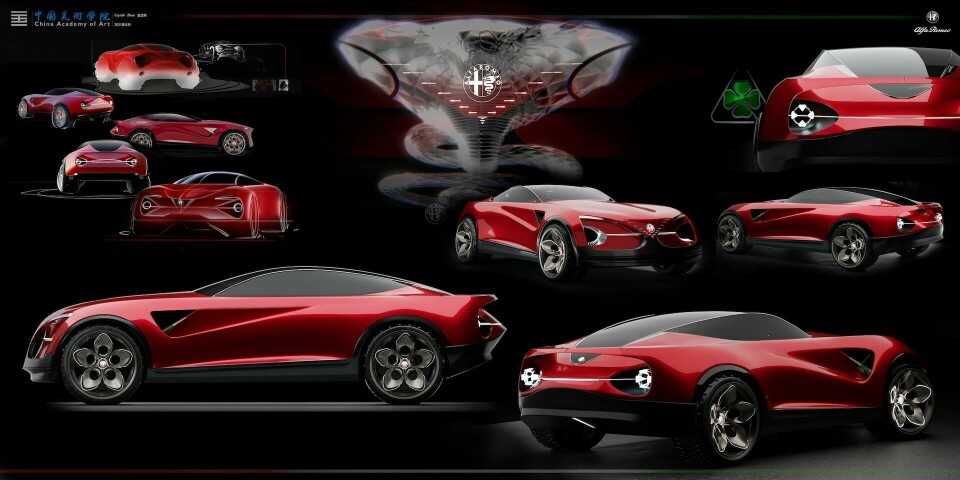
Shooting Rattler by Hanci Hong
While many of these concepts have leaned on the characteristics of a serpent for the design language, this one goes a little further. Indeed, the Shooting Rattler is described as a ‘hunting vehicle’ and is designed to shuttle between urban and outdoor environments – say the forest, to the city.
“Taking inspiration from the rattlesnake, Shooting Rattler’s overall design is light and agile, expressing its flexibility,” says Hong. A fresh take on the shooting brake, perhaps?
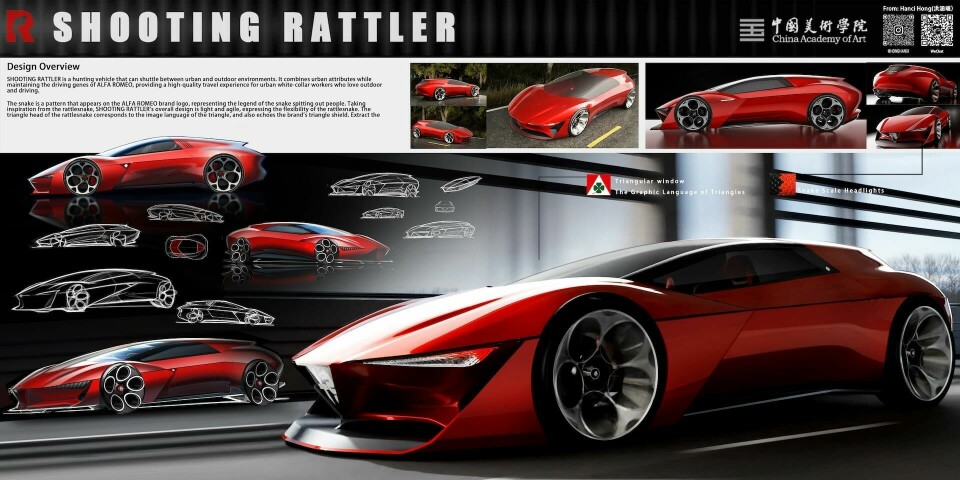
Dialog GT-300 by Haoyang Liu
From the 1930 Alfa Romeo 6C 1750 Gran Turismo – “the first GT car” in Liu’s words – to the electrified GT of the future in 2030: the GT-300. It is certainly futuristic, sitting low to the ground with super sleek, stretched bodywork and a long bonnet.
A side by side comparison with the 6C 1750 that came 100 years before it reveals similar design cues, particularly in the flowing shoulder line that rises and falls to accentuate its rear haunches. Contrasting with the retro cues is the rear light signature, which seemingly floats in mid air across the entire rear of the car. The circular headlamps feel a little more familiar, almost reminscent of modern Alfas like the 8C.

PEAK X by Henry Zhang
Zhang clearly took Alfa Romeo’s heritage seriously when putting together the PEAK X concept, noting that the brand embues “driving passion that never fades.” As we have seen with other degree shows, students today often envision vehicles that are as capable off-road as they are on smooth tarmac. The PEAK X concept aims to do something similar, catering to a ‘Speed Peak’ racing event taking place in 2030, designed for outdoor high-performance vehicles. Think Pikes Peak, but a little less extreme.
Inside, the cockpit features a triangular three-seat layout with the driver at the head of the arrow, centering them in the driving experience. The exterior desig and overall proportions were inspired partly by classic models (1955 750 Competizione, 1970 Montreal) and modern high-riding SUVs like the Stelvio and Tonale. The result is a near-horizontal roofline that sits ever so slightly above the bonnet and rear bootlid – which features a dramatic undercut section.
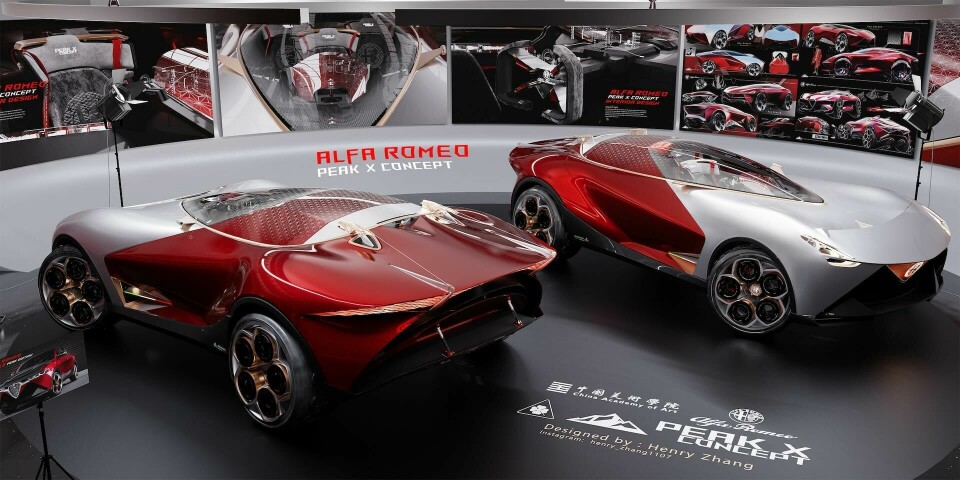
Puglia by Norman Xie
The Puglia is a long-wheelbase electric GT aimed at luxury buyers in the year 2030. Benchmarked not on an Alfa Romeo but its sister brand with the Maserati GranTurismo, the Puglia carries proportions typical of this segment but employs a three-seat layout with two passengers at the rear. Two driving modes are offered, and in automatic mode all three passengers are aligned.
Indeed, although the vehicle has GT proportions it is in fact more heavily inspired by speedboats and the Alfa Romeo’s 1950s B.A.T. concepts. The nautical theme carries through to the interior and CMF, illustrated nicely with a series of sketches and moodboards.
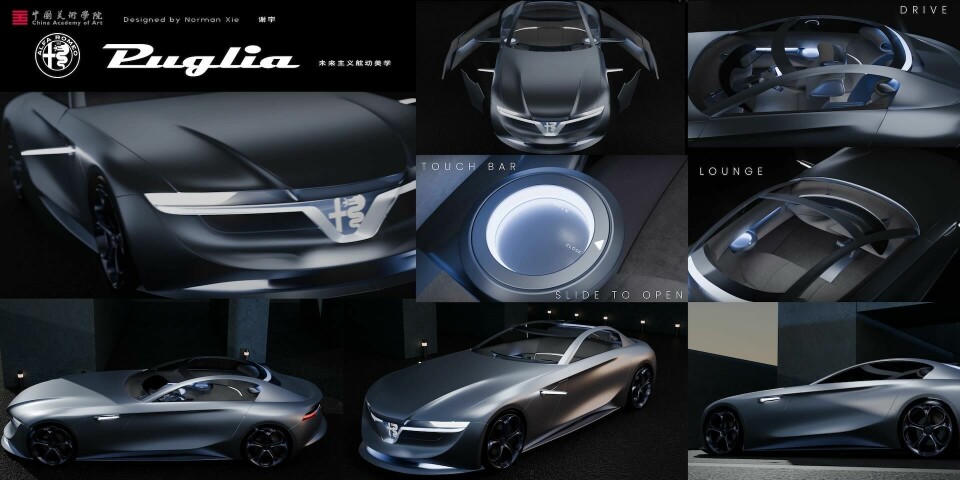
SIA by Orange Liu
This project began with a look back at Alfa Romeo’s Formula 1 racers between 1950 and 1985, with a vision of creating a ‘next-generation hypercar’ for the brand. Liu considered how vehicles are often described as moving sculptures, and studied how these static shapes often begin with strong bases. Care and attention went towards sculpting the lower section of the car to provide a suitable foundation that prioritises downforce.
The result is an angular almost shape-shifting exterior that showcases a mixture of interesting angles, cut-out sections and aerodynamic bodywork. The Formula 1 influence is particularly evident at the front axle, which is almost left on display by the sills that taper in behind the front wheel.
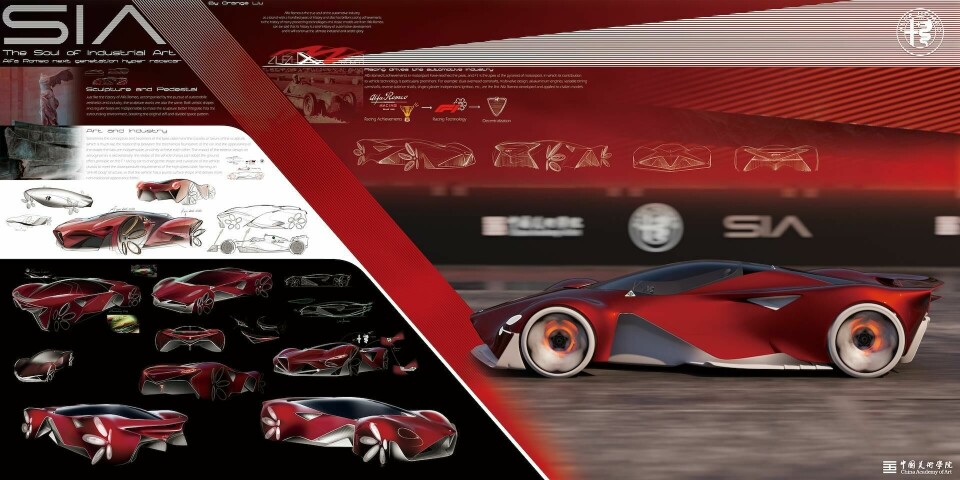
Nano S by Paul Quinland
Quinland’s project builds on the trend of spiralling urbanisation, which promises to create ever-more crowded cities and urban areas. Roads would be narrow, and traffic heavy. As such, the Nano S is seen as useful addition to the Alfa portfolio and “opens up a younger user market.”
The idea is to bridge the compact utility of a short-wheelbase off-roader (like a Land Rover Defender 90) and the agility of a go kart, with “the same body providing different characters.” Inspiration came from a variety of other sources, including passenger bi-planes, ornaments and… marbles. The final concept feels like a reasonable evolution of the Mito city car.

ALO by Ryan Wei
In 2040, an innovative new lithium-oxygen battery technology will have been industrialised and put into practice in motor racing. In simple terms, the vehicle generates energy as it drives using a large fan at the centre of the car, which rotates as the vehicle pushes through the air. Like other concepts in this collaboration project, the 33 Stradale served as inspiration but the resulting form feels very much unique.
The front light signature is particularly striking, highlighting the prominent air ducts either side of the car’s nose. The cockpit is designed for a single passenger, allowing for an exceptionally narrow glasshouse and a dramatic taper at the hips.

Traceur by Winter Li
This concept channels the spirit of “freedom and creativity” found in both motor racing and urban street gymnastics known as ‘parkour’. This involves navigating the city, pushing the limits of the human body and finding innovative ways to scale urban landscapes. Li believes this dovetails nicely with the principles of motor racing, and the Traceur concept balances both of these themes as it is not limited by the terrain that faces it.
The cockpit layout was inspired by bobsled racing, with driver and passenger sitting in line with one another. The basic proportions and front end are reminiscent of the Tonale, but elevated toward a new vehicle typology with a much longer wheelbase, higher ride height and absence of a roof.
